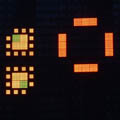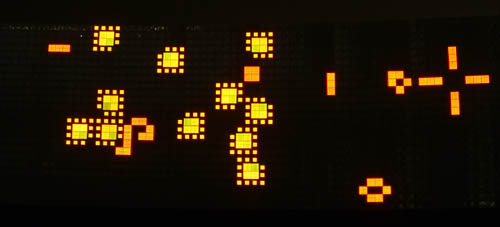 |
 |
||
|
|
|
||
|
|
Loop Emergence This application is the combination of two other ones: Life and Loops. The emergence of the minimal 2x2 self-replicating loop occurs in a Game of Life environment. On the BioWall, this emergence is implemented as a uniform two-dimensional Life/Loop cellular automaton, where each cell is made up of a Life state machine and a Loop state machine. The Life machine requires a nine-neighbor environment with a dead state and a living state per cell. The state of the machine at the next time-step depends on the number of neighboring cells that have a current living state (Figure 1).
The Loop machine requires a five-neighbor environment with 16 states per cell. The transition rules of the machine define a minimal 2x2 loop that remains idle without external input. When the user activates one of the four cells of the idle loop, a self-replication process or a self-destruction process takes place (Figure 2).
In the BioWall implementation, the two-dimensional cellular space is initialized as an empty Life environment where the user can induce birth of cells by physically touching them. The rules of the Life application are in use and motifs like squares, blinkers or gliders will appear. EmergenceIn the Life environment, each living cell presents randomly one of the idle loop states at each time-step. The context switch between Life and Loop happens when a square block of four adjacent cells detects one of the four configurations of the idle loop . Depending on the absence or presence of surrounding loops, the physical activation of the idle loop induces a self-replication (Figure 3) or self-destruction process (Figure 4). While performing these processes, the cellular space colonized by replication shifts to the Loop context and the cellular space freed by destruction returns to the Life context.
For further information
Resources
|







